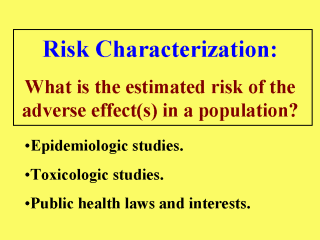|
|
|
|
front |1 |2 |3 |4 |5 |6 |7 |8 |9 |10 |11 |12 |13 |14 |15 |16 |17 |18 |19 |20 |21 |22 |23 |24 |review |
 |
This is the fourth and final formal step in health risk assessment (RA), in which hazard identification and exposure information are brought together to describe and estimate the overall health risk from exposure of the toxic agent of concern. The key issues considered in risk characterization generally include: the strength and weight of evidence; the potency of the effect; the populations affected; the types of health effects; the likelihood of the exposure; and, to a great extent, the public concerns over these issues. In this final step, the data from the epidemiologic studies and animal bioassays used are weighted and contrasted, and the confidence in them is considered. Both the epidemiological evidence and the toxicological data learned are used to delineate the type(s) of health effects involved, and to assess their potency. Although epidemiologic studies and statistical methods are primarily used to determine the likelihood of the exposure and the populations affected, public health laws and interests play an important role here. For example, the Occupational Safety and Health Act of 1970 was passed by U.S. Congress to regulate human exposures to toxic and carcinogenic agents occurring only in the workplace. On the other hand, the Food Quality Protection Act of 1996 mandates that there [be] a reasonable certainty that no harm [shall] result from aggregate exposure to the pesticide chemical residue, including all anticipated dietary exposures and all other exposures for which there is reliable information. |